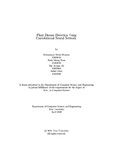| dc.contributor.advisor | Hossain, Muhammad Iqbal | |
| dc.contributor.author | Hossain, Mohammad Shifat | |
| dc.contributor.author | Noor, Fatin Ishraq | |
| dc.contributor.author | Ali, Mir Ayman | |
| dc.contributor.author | Alam, Ra ul | |
| dc.date.accessioned | 2021-07-03T19:21:18Z | |
| dc.date.available | 2021-07-03T19:21:18Z | |
| dc.date.copyright | 2020 | |
| dc.date.issued | 2020-04 | |
| dc.identifier.other | ID 15101044 | |
| dc.identifier.other | ID 15301086 | |
| dc.identifier.other | 15101104 | |
| dc.identifier.other | ID 15101130 | |
| dc.identifier.uri | http://hdl.handle.net/10361/14732 | |
| dc.description | This thesis is submitted in partial fulfillment of the requirements for the degree of Bachelor of Science in Computer Science and Engineering, 2020. | en_US |
| dc.description | Cataloged from PDF version of thesis. | |
| dc.description | Includes bibliographical references (pages 24-26). | |
| dc.description.abstract | Rice is a staple crop of Bangladesh and many metric tons of it are being destroyed
every year due to diseases. If the diseases can be efficiently and accurately classified ed
and recognized at early stage, the farmers can get the required help resulting in
better rice crop yields. Thus, in an attempt to better increase the rice crop, yield our
proposal is to make a website prototype system by using different machine learning
algorithms to analyze and recognize different rice crop diseases. By utilizing CNN
and its variations for the detection of rice plant diseases, we aim to guide individuals
and assist farmers in identifying the infected plants early. By doing so, automated
systems can be made to find out the infected crops and suggest diagnosis based
on the problems. The photographs of rice plant leaves are taken for brown spot,
Hispa and leaf blast diseases. We have used Convolution Neural Network (CNN)
which comprises of different layers which are used for prediction. In addition, we
have implemented other 4 CNN structures such as GoogleNet, RestNet-152 and
VGG19 which is 19-layer deep structure. On the other hand, the features from the
infected area are extracted using Histogram Oriented Gradient (HOG) features and
for distinguishing between their category these features were given to the Support
Vector Machine (SVM). To sum up, by experimentation we will be able to conclude
which structure or algorithm has the most success rate. As a result, by this approach
the information will be provide at the initial stage so that one can take necessary
steps at the beginning to prevent the rice plant diseases and minimize the loss of
production. | en_US |
| dc.description.statementofresponsibility | Mohammad Shifat Hossain | |
| dc.description.statementofresponsibility | Fatin Ishraq Noor | |
| dc.description.statementofresponsibility | Mir Ayman Ali | |
| dc.description.statementofresponsibility | Ra ul Alam | |
| dc.format.extent | 26 pages | |
| dc.language.iso | en | en_US |
| dc.publisher | Brac University | en_US |
| dc.rights | Brac University theses are protected by copyright. They may be viewed from this source for any purpose, but reproduction or distribution in any format is prohibited without written permission. | |
| dc.subject | Rice plant disease | en_US |
| dc.subject | Detection | en_US |
| dc.subject | Prediction | en_US |
| dc.subject | ResNet- 152 | en_US |
| dc.subject | Convolutional Neural Network | en_US |
| dc.subject.lcsh | Machine learning | |
| dc.title | Plant disease detection using convolutional neural network | en_US |
| dc.type | Thesis | en_US |
| dc.contributor.department | Department of Computer Science and Engineering, Brac University | |
| dc.description.degree | B. Computer Science | |

